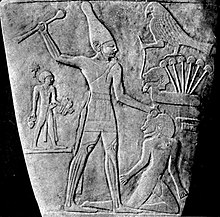Wash (pharaoh)
[2][3][4] The reverse of the Palette depicts a kneeling captive, "un-Egyptian in appearance", about to be clubbed by the far larger figure of Narmer.
[5][6] Just as Narmer has a rebus representing his name carved next to him on the front of the palette (a catfish above a chisel), two primitive hieroglyphs appear near the captive.
Scholars have considered this harpoon-and-lake rebus as either a representation of the Harpoon nome, a community in the Northwestern Nile Delta next to the Libyan borders, or the captive's personal name.
However, rather than recording this historical event the palette may simply depict an allegory for Narmer's excellence and right of command, with the figure of Wash having been recruited to the task.
[8] Archaeologist Edwin van den Brink argued that another predynastic Lower Egyptian ruler, Hedju Hor, is the figure depicted as Wash. van den Brink based this argument on the similarities between Hor's own heraldic crest, his serekh, and the carving above Wash on the Narmer palette depicting Horus leading a ship out of papyrus reeds with a rope through the nose of its male figurehead.
